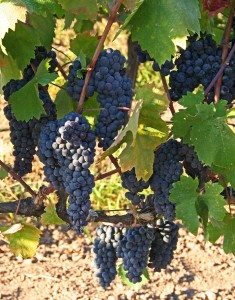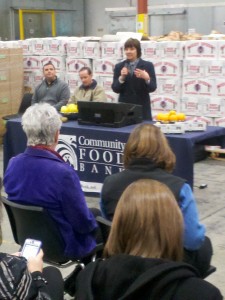http://www.gov.ca.gov/news.php?id=17366
Governor Brown Announces Appointments
12-29-2011
SACRAMENTO – Governor Edmund G. Brown Jr. today announced the following appointments.
Angel Barajas, 29, of Woodland, has been appointed to the 40th District Agricultural Association, Yolo County Fair Board. Barajas has served as a labor representative at the Service Employees International Union Local 1000 since 2007. He was an assistant deputy supervisor for Yolo County Supervisor Frank Siefman from 2006 to 2007. Barajas is currently president of the Woodland Joint Unified School District, where he has been a member since 2010. This position does not require Senate confirmation and there is no compensation. Barajas is a Democrat.
Glenna Blake, 70, of Ukiah, has been appointed to the 12th District Agricultural Association, Redwood Empire Fair Board. She has been the marketing and planning manager at the Mendocino Transit Authority since 1994. Blake was co-manager of Willits Fitness World from 1986 to 1994. This position does not require Senate confirmation and there is no compensation. Blake is a Democrat.
Ashley Boren, 50, of San Francisco, has been appointed to the California State Board of Food and Agriculture, where she has been a member since 2008. Boren has served as executive director at Sustainable Conservation since 1997. She worked at Smith and Hawken from 1989 to 1997, serving in multiple positions, including director of retail merchandising. She earned a Master of Business Administration from the Stanford Graduate School of Business. This position does not require Senate confirmation and there is no compensation. Boren is a Democrat.
Casey Burris, 36, of Ukiah, has been appointed to the 12th District Agricultural Association, Redwood Empire Fair Board. He has been vice president of operations for J.A. Sutherland, Inc. since 2000. He worked at Savings Bank of Mendocino County from 1991 to 2000, serving in multiple positions, including information technology specialist. This position does not require Senate confirmation and there is no compensation. Burris is registered decline-to-state.
Grace Calderon, 65, of Tulare, has been appointed to the 24th District Agricultural Association, Tulare County Fair Board. She was a family service worker at the Tulare County Office of Education from 1970 to 2006. This position does not require Senate confirmation and there is no compensation. Calderon is a Democrat.
Charles Coleman, 55, of Redwood Valley, has been appointed to the 12th District Agricultural Association, Redwood Empire Fair Board. He is a retired fire captain at the California Department of Forestry and Fire Protection, where he served from 1973 to 2006. This position does not require Senate confirmation and there is no compensation. Coleman is a Democrat.
Pablo Contreras, 63, of Dinuba, has been appointed to the 24th District Agricultural Association, Tulare County Fair Board. He has been an enrolled agent and owner of PM Contreras since 1976. Contreras has been chair of the Dinuba Police Commission since 2000. This position does not require Senate confirmation and there is no compensation. Contreras is a Democrat.
Eric Crawford, 43, of Ukiah, has been appointed to the 12th District Agricultural Association, Redwood Empire Fair Board. He has been an agriculture science instructor with the Mendocino County Office of Education since 1997. Crawford was an agriculture science instructor with the Santa Cruz County Office of Education from 1995 to 1997. This position does not require Senate confirmation and there is no compensation. Crawford is registered decline-to-state.
Samuel Fant, 23, of Stockton, has been appointed to the 2nd District Agricultural Association, San Joaquin County Fair Board. Fant has been director of Sierra Vista Community Center since 2010. He held multiple positions at the Boys and Girls Clubs of Stockton from 2007 to 2010, including director of the Gary and Janice Podesto Impact Team Center. He is currently chair of the Stockton City Planning Commission, where he has been a member since 2009. This position does not require Senate confirmation and there is no compensation. Fant is a Democrat.
Christopher Flaherty, 43, of Stockton, has been appointed to the 2nd District Agricultural Association, San Joaquin County Fair Board. Flaherty has been the president and chief executive officer of Trinity Development and Construction, Inc. since 2003. He was managing officer at the Vineyard Development and Management Company from 1999 to 2003. Flaherty was the owner of Flaherty Farms and Livestock from 1994 to 2000. He has been a founding member of the Stockton Olive Oil Project Charitable Organization since 2003. This position does not require Senate confirmation and there is no compensation. Flaherty is a Republican.
Don Huffman, 48, of Napa, has been appointed to the 25th District Agricultural Association, Napa Town and Country Fair. He has been a consultant for Huffman Communications and owner of Mediabend since 1999. Huffman currently serves as vice president for the Napa County Office of Education, where he has been a trustee since 2009. He was vice president of client services for Elliott Dickens from 1996 to 1998. Huffman was an account director at Kraigie Newell from 1990 to 1996. This position does not require Senate confirmation and there is no compensation. Huffman is a Democrat.
Roberto Muniz, 41, of Redwood Valley, has been appointed to the 12th District Agricultural Association, Redwood Empire Fair Board, where he has been a member since 2003. He has been a claims representative at the U.S. Social Security Administration since 2003. Muniz held multiple positions at the Mendocino County Welfare Office from 1993 to 2004, including employment representative. This position does not require Senate confirmation and there is no compensation. Muniz is a Democrat.
Darren Parker, 51, of Lancaster, has been appointed to the 50th District Agricultural Association, Antelope Valley Fair Board. He has been a partner at the Parker Group since 2009. Parker worked at AT&T from 1979 to 2009, serving in multiple positions, including network operations manager. This position does not require Senate confirmation and there is no compensation. Parker is a Democrat.
Ginger Pohlson, 69, of Willits, has been appointed to the 12th District Agricultural Association, Redwood Empire Fair Board. She was a recreation employee at the Brooktrails Community Services District from 1990 to 2000. Pohlson is a member of the Ukiah Civic Light Opera and secretary of the Willits Police Activities League. This position does not require Senate confirmation and there is no compensation. Pohlson is a Democrat.
Miles Reiter, 62, of Aptos, has been appointed to the California State Board of Food and Agriculture. Reiter has been chairman at Driscoll Strawberry Associates, Inc. since 1988, where he has served as chief executive officer since 2000. He was president at Aptos Berry Farms, Inc. from 1977 to 2000. He served on the board of directors for the Produce Marketing Association from 2007 to 2010 and its retail board from 2003 to 2006. Reiter served on the board of directors for the Western Growers Association from 2002 to 2009. This position does not require Senate confirmation and there is no compensation. Reiter is a Republican.
Laurie Schuler-Flynn, 49, of Woodland, has been appointed to the 40th District Agricultural Association, Yolo County Fair Board. Schuler-Flynn has been an agricultural and standards specialist for the Yolo County Agricultural Commissioner’s Office since 1988. She has been a co-owner of Hill Stone Olive Oil since 2004. Schuler-Flynn has been a member of the California Olive Oil Council since 2006. This position does not require Senate confirmation and there is no compensation. Schuler-Flynn is a Democrat.
Bart Vanucci, 47, of Brooks, has been appointed to the 40th District Agricultural Association, Yolo County Fair Board. He has served as a financial advisor for Primerica Financial Services since 1987. Vanucci has been a volunteer with the Yolo County Future Farmers of America Leadership Council since 1997. This position does not require Senate confirmation and there is no compensation. Vanucci is a Republican.
Katie Villegas, 45, of West Sacramento, has been appointed to the 40th District Agricultural Association, Yolo County Fair Board, where she has been a member since 2009. She has served as executive director of the Yolo County Children’s Alliance since 2006. Villegas was an analyst at the California Department of Alcohol and Drug Programs in 2005 and an analyst at the Department of Public Health from 1991 to 2005. This position does not require Senate confirmation and there is no compensation. Villegas is a Democrat.
David Whaley, 55, of Visalia, has been appointed to the 24th District Agricultural Association, Tulare County Fair Board. He is a retired undersheriff with the Tulare County Sheriff’s Department, where he served from 1974 to 2009. Whaley has owned and operated a family ranch since 1985. This position does not require Senate confirmation and there is no compensation. Whaley is a Republican.
Elaine Yamaguchi, 47, of Woodland, has been appointed to the 40th District Agricultural Association, Yolo County Fair Board. She has served as a legislative analyst at the California Public Employees Retirement System since 2007. Yamaguchi was the director of the California Civil Liberties Public Education Program at the California State Library from 2005 to 2006. She served as special assistant in the Office of the Speaker of the Assembly from 1998 to 2005. Yamaguchi held multiple positions at the Center for Asian American Media from 1993 to 1997, including managing director. This position does not require Senate confirmation and there is no compensation. Yamaguchi is a Democrat.






